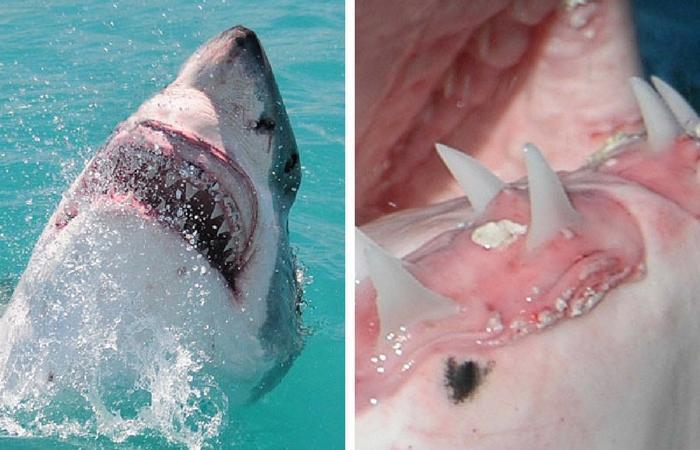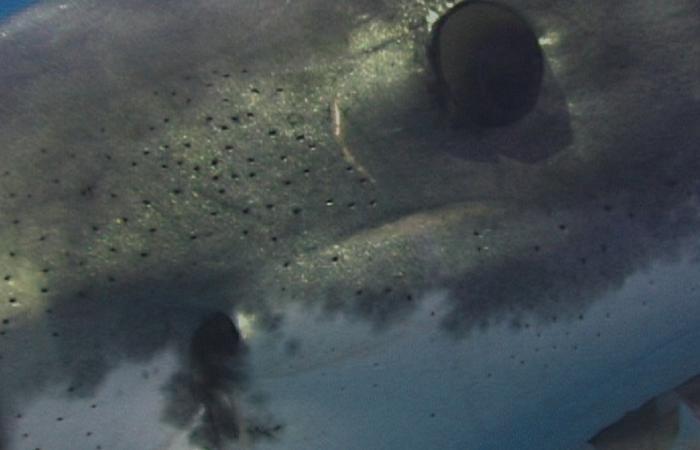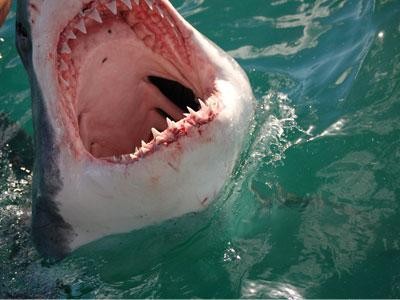A great white can go through 20 000 razor sharp teeth in one life

When this predator comes for you, you don't see the shark, you just see two-inch triangular teeth. For decades this ancient hunting machine has terrified beachgoers across the globe.
Triangular razor-sharp teeth
This mouth of razorblades is just a necessary feeding apparatus of a super-sized fish. The great white shark is one of the world’s most notorious predators. But still, it would be nothing without its 300 serrated teeth. They’re designed to rip and grip through flesh, much like we use a knife and fork. And its jaw crunches down with almost two tonnes of force.
What is even more frightening is this fearsome fish has a never-ending supply of battle-ready blades. The great white’s teeth a rooted in the soft cartilage, not bone, and often fall out or break. Its solution is rows of replacement teeth found inside the jawbone. The new teeth roll info action like a vending machine; meaning razor-sharp weapons are always at the ready. A great white can go through over 20 000 teeth in its lifetime.

Hear without ears
When hunting seals off Gansbaai at the coast of South Africa, the bizarre but fascinating senses lead her to her next victim. The great white does not have regular ears for hearing. Inst, ad she hears with minuscule hairs found in tiny fluid-filled tubes along both sides of her body. When the colony leaves the safety of the rocky island for deep-sea fishing grounds, not a single splash or jump, goes unheard by this shark’s weird auditory system.
Scent of a seal
The great white’s nostrils are 10 000 times more sensitive than human ears. They can detect a single drop of seal oil in a body of water the equivalent of an Olympic sized swimming pool. Tiny jelly-filled pores on her nose can absorb minute electrical pulses created by the muscular contractions of moving prey, meaning this fishy beast can home in on a single seal’s heartbeat.

Blue eyes
This super predator’s eyes are also five times the size of ours. And behind each retina lie crystal plates that reflect light in the murky water.
There is nothing a seal can do against a three-ton fish with a mouth full of blades. There is nowhere to hide.
Teeth and Jaws
Like all sharks, the great white has jaws that are unique from other animals because both the top and bottom jaws move. A great white shark will ambush its prey, attack by biting with the lower jaw and then its upper jaw. It shakes its head back and forth tearing off a large piece of meat and swallowing it whole.
Plenty of Teeth to Spare
A great white shark, like all sharks, may have up to 3,000 teeth at one time with five rows of teeth at any given time. The front set of teeth is the largest and does most of the biting. Like all sharks, the great white shark may grow and use more than 20,000 teeth in its lifetime. In common with all sharks, the great white will never run out of teeth because if one is lost, another spins forward from a coil-like tooth reservoir of backup teeth in the jaw and spins forward to replace the old one.
Jaws Like a Cat's Claw
The great white shark has rows of teeth behind the main ones. The teeth are unattached to the jaw and are retractable, like a cat's claw, moving into place when the jaw is opened. The great white shark's teeth rotate on their own axis, moving outward when the jaw is opened and inward when the jaw is closed. The great white shark's teeth are linked to pressure and senor-sensing nerve cells, which give their teeth high tactile sensitivity.
Bite-Size Morsels
The great white shark feeds on small fish, other sharks, turtles, dolphins, and pinnipeds such as seals and sea lions. In a single bite, a great white can take in up to 30 pounds of flesh, devouring a total of over several hundred pounds of flesh at each feeding. Although the great white has a high metabolism and has the ability to maintain a body temperature of around 14 degrees Celsius (57 degrees Fahrenheit), it can go weeks without eating.
The Great White's Role in Ecology
The large, sharp and numerous teeth of the great white shark help facilitate its crucial role as ocean janitor. The shark feeds on many sea animals, including the injured, sick and diseased. By doing this, the shark cleans up the sea as it munches its way along the ocean's surface to depths of 1,280 meters deep, or 4,200 feet.

.png)

